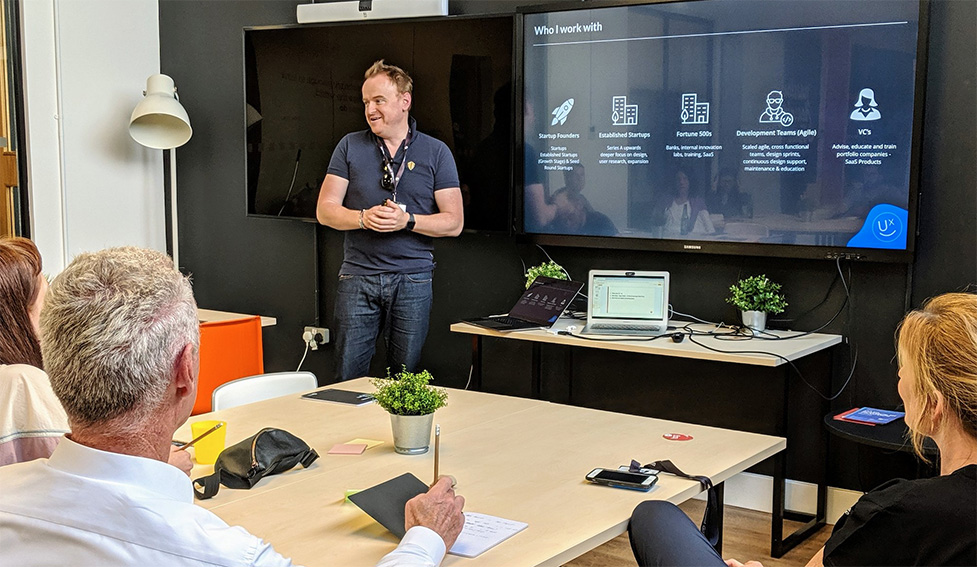Design
7
min read
How to Conduct Effective In-Site Interviews as a UX Researcher


Don't you want to read? Try listening to the article in audio mode 🎧
As a UX researcher, gaining insight into your users' needs and behaviors is crucial for designing effective and user-friendly products. While online surveys and remote user testing can provide valuable insights, there are times when it's necessary to go beyond these methods and conduct in-site interviews. In-site interviews provide a unique opportunity to observe users in their natural environment, and gather more nuanced and contextual data about their experiences. In addition to this, there are several other advantages to conducting in-site interviews, including:
- Building empathy: In-site interviews allow researchers to develop a deeper understanding of users by observing them in context, and engaging with them in conversation. This can help researchers build empathy with users and gain a more holistic understanding of their needs.
- Uncovering unexpected insights: By observing users in their natural environment, researchers may discover unexpected insights that they would have missed through remote testing or surveys. These insights can inform design decisions and lead to more innovative solutions.
- Facilitating co-creation: In-site interviews can facilitate co-creation by involving users in the design process. By working collaboratively with users to identify pain points and co-create solutions, researchers can develop more user-centered designs that meet users' needs.
Before the interview: Preparing for In-Site Interviews
Before conducting in-site interviews as a UX researcher, it's important to properly prepare to ensure that you're collecting valuable data that aligns with your research objectives. In this section, we'll outline the necessary steps to prepare for in-site interviews, including identifying the right participants, setting goals and objectives, and creating a discussion guide. By following these steps, you'll be equipped to conduct effective in-site interviews that provide insights into user behavior and needs.Identify the right participants:
Before conducting in-site interviews, it's important to identify the right participants. This involves determining the characteristics and behaviors that are relevant to your research objectives. For example, if you're researching the use of mobile devices in a specific context, you might seek out participants who use mobile devices in that context.Set goals and objectives:
It's important to set clear goals and objectives for your in-site interviews to ensure that you're collecting the data you need. These goals and objectives should align with your overall research objectives and guide your approach to the interviews. For example, your goal might be to understand how users interact with a product in a specific context, while your objectives might include identifying pain points and areas for improvement.Create a discussion guide:
A discussion guide is a structured set of questions and prompts that you'll use to guide the conversation during the interview. It's important to create a discussion guide that is tailored to your research objectives and the participants you'll be interviewing. Your discussion guide should include open-ended questions that allow participants to share their experiences and perspectives, as well as more specific prompts to help you gather the information you need.Choose the right location and equipment:
Choosing the right location for your in-site interviews is essential to ensure that you're able to gather the data you need. This might involve visiting a participant's home or workplace, or conducting the interview in a specific environment such as a store or a public space. You'll also need to ensure that you have the right equipment for the interview, such as a camera, microphone, or notepad.Recruit and schedule participants:
Once you've identified the right participants, it's time to recruit and schedule them for the interviews. This might involve reaching out to your network or using a recruiting agency to find participants who match your criteria. You'll also need to schedule the interviews at a time and location that is convenient for both you and the participant.Train interviewers:
If you're working with a team of interviewers, it's important to train them on the research objectives, discussion guide, and any specific techniques or protocols you'll be using during the interviews. This will ensure that all interviewers are on the same page and collecting consistent data. By following these steps, you'll be well-prepared to conduct effective in-site interviews that provide valuable insights into user behavior and needs.Conducting the In-Site Interview: do’s and don’ts
Conducting in-site interviews as a UX researcher can be a valuable way to gain insights into user behavior and needs. However, it's important to conduct the interviews effectively to ensure that you're collecting high-quality data that aligns with your research objectives. In this section, we'll provide tips and strategies for conducting effective in-site interviews, including the do's and don'ts of the interview process.Do's:
Establish rapport:
Establishing rapport with your interviewee is crucial for a successful interview. Building rapport can help put the interviewee at ease, encourage them to open up, and create a more comfortable and productive environment for the interview. One way to establish rapport is to begin the interview with some informal conversation, such as asking about their day or hobbies.Active listening:
Active listening is essential during the interview process to ensure that you're truly understanding the interviewee's responses and capturing their experiences and perspectives. To actively listen, you should focus your attention on the interviewee, ask clarifying questions, and reflect on their responses to show that you understand.Probing for deeper insights:
Probing for deeper insights can help you uncover more detailed and nuanced information from your interviewee. This involves asking follow-up questions that encourage the interviewee to expand on their initial responses and provide more detail. For example, you might ask "Can you tell me more about that?" or "How did that make you feel?" to encourage the interviewee to share more information.Keeping the conversation on track:
Keeping the conversation on track is important to ensure that you're collecting data that aligns with your research objectives. You should use your discussion guide to guide the conversation and ask follow-up questions as needed. However, you should also be flexible and willing to adapt to the interviewee's responses and follow their lead if they bring up relevant topics outside of the discussion guide.Managing time:
Managing time effectively is important to ensure that you're able to cover all of the necessary topics within the allotted time frame. Before the interview, you should plan out the interview schedule and ensure that you're leaving enough time for each topic. During the interview, you should keep an eye on the time and adjust your questions or follow-up probes as needed to stay on track.Don'ts:
Leading questions:
Leading questions can bias the interviewee's responses and lead to inaccurate or incomplete data. To avoid leading questions, you should use open-ended questions that encourage the interviewee to share their experiences and perspectives in their own words.Interrupting:
Interrupting the interviewee can be disruptive and make them feel unheard or disrespected. To avoid interrupting, you should let the interviewee finish speaking before responding, even if there is a pause or silence. You should also avoid multitasking or getting distracted during the interview, as this can make it more difficult to actively listen and engage with the interviewee.Judging or criticizing:
Judging or criticizing the interviewee's responses can make them feel uncomfortable or defensive, and may hinder their willingness to share their experiences and perspectives. To avoid judging or criticizing, you should maintain a neutral and non-judgmental tone throughout the interview, and focus on understanding the interviewee's perspective rather than evaluating it. By following these do's and don'ts, you'll be better equipped to conduct effective in-site interviews that provide valuable insights into user behavior and needs.After the interviews: Analyzing and Synthesizing Data
Once you've conducted your in-site interviews, the next step is to analyze and synthesize the data you've collected. This involves reviewing the data, identifying patterns and themes, organizing and categorizing the data, and prioritizing findings. In this section, we'll discuss these steps in more detail.Review the data:
The first step in analyzing and synthesizing your data is to review all the data you've collected. This includes audio recordings, transcripts, notes, and any other materials you've gathered during the interviews. As you review the data, take note of any key insights, themes, or patterns that emerge. It can be helpful to use a tool or software to organize your data, such as a spreadsheet or a qualitative analysis software.Identify patterns and themes:
Once you've reviewed your data, the next step is to identify any patterns or themes that emerge. These can be anything from recurring topics or issues that participants bring up, to common experiences or behaviors that you observe. You may also want to look for outliers or unexpected responses, as these can provide valuable insights into user needs or pain points.Organize and categorize data:
After identifying patterns and themes, the next step is to organize and categorize your data. This can help you to make sense of the data and identify any gaps or inconsistencies. You might categorize your data by participant demographics (e.g. age, gender), by topic (e.g. navigation, content), or by other factors that are relevant to your research objectives.Prioritize findings:
Once you've organized and categorized your data, the next step is to prioritize your findings. This involves identifying the most important insights or themes that emerged from the data, and determining which findings are most relevant to your research objectives. You may also want to consider the frequency or significance of each finding, as well as any potential implications for your design or research.Synthesize insights:
Finally, you'll need to synthesize your insights into a cohesive set of findings that can guide your design or research decisions. This may involve creating personas or user journey maps that represent different user needs or behaviors, or it may involve identifying specific design recommendations that address key user pain points or challenges. Overall, analyzing and synthesizing data from in-site interviews can be a complex and time-consuming process, but it's essential for gaining valuable insights into user behavior and needs. By following these steps, you'll be better equipped to analyze and synthesize your data effectively, and use your findings to inform your design and research decisions.Conclusion: Using Findings to Improve UX Design
After conducting in-site interviews and analyzing the data, you should have a wealth of insights into user behavior and needs. The next step is to use these findings to improve your UX design. This involves making informed design decisions, prioritizing features, and developing a more user-centered approach. By incorporating user feedback into your design process, you'll be able to create products and services that are more effective, usable, and satisfying for your users. So, be sure to take the time to analyze your in-site interview data thoroughly and use the insights gained to inform your design decisions.
Article updated on: 09 August 2023

Don't Waste Your Talent. Turn It Into a Career With a Course That Fits Your Needs!
Talent Garden is your Digital Skills Academy, offering courses in Digital Marketing, UX Design, Digital HR and Data Analysis designed to launch your career.
Keep reading

12
min read
UX Design: A complete guide to plan an efficient User Experience
When creating any digital project, the focus must now be on the user. Websites, marketing campaigns, posts and social ...
Talent Garden
22/01/2019

5
min read
What is a Customer Journey Map, what it is used for and how to create it
Some of the fundamental questions all businesses should ask themselves are: how do users use our product? What are the ...
Talent Garden
04/03/2022

5
min read
User Research: the key to successful project development
Making an analysis of the User Experience Research done on a product or a service, looking at what satisfies the user, ...
Talent Garden
15/05/2019

4
min read
UX Design: The Challenges and Opportunities
"The next big thing in UX is already here and is being explored and built at great speed around us"- Mark Swaine The ...
Talent Garden
17/10/2019
